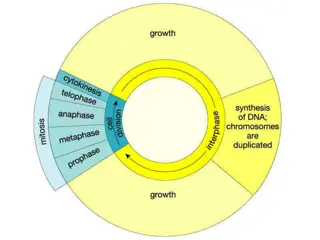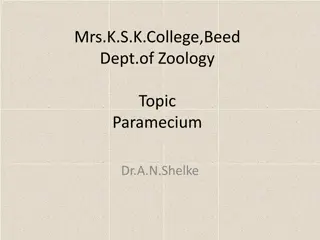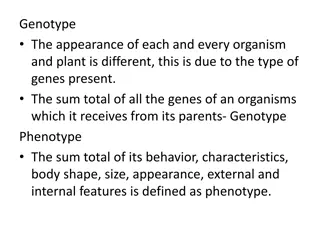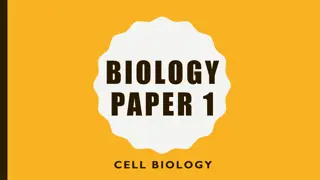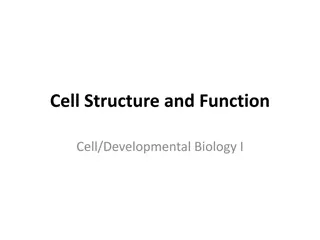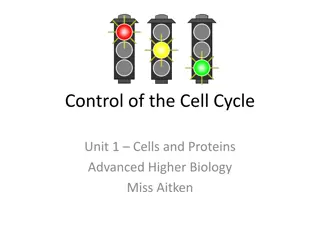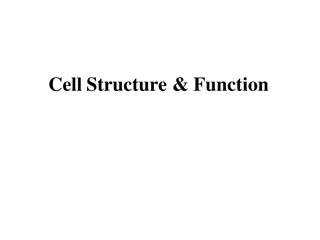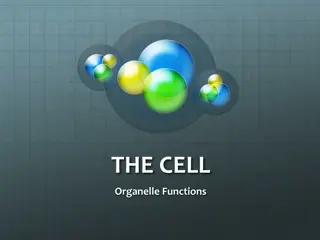Biology Revision with AQA Trilogy: Cell Biology and Organism Organization
In this biology revision session for AQA Trilogy, we delve into topics like cell biology, organism organization, diffusion, osmosis, active transport, enzymes, and more. Explore the differences between prokaryotes and eukaryotes, understand cell specialization, and learn about key processes like mitosis and stem cells. Enhance your knowledge with practical calculations and detailed explanations to excel in your assessments.
Download Presentation

Please find below an Image/Link to download the presentation.
The content on the website is provided AS IS for your information and personal use only. It may not be sold, licensed, or shared on other websites without obtaining consent from the author.If you encounter any issues during the download, it is possible that the publisher has removed the file from their server.
You are allowed to download the files provided on this website for personal or commercial use, subject to the condition that they are used lawfully. All files are the property of their respective owners.
The content on the website is provided AS IS for your information and personal use only. It may not be sold, licensed, or shared on other websites without obtaining consent from the author.
E N D
Presentation Transcript
Biology Revision AQA Trilogy Use your PLC to choose a topic to revise and complete the tasks B1 Cell Biology B2 Organisation B3 Infection and Response B4 Bioenergetics Assessment Paper 1: Biology 1 (70 marks -16.7% of GCSE )
Calculate the magnification if you have a magnified image that s 5mm wide and an object that is 0.05mm wide. Give three differences between prokaryotes and eukaryotes: Write the equation used to work out magnification B1 Cell Biology AQA Trilogy Calculate the image size if your specimen is 0.1mm wide and the magnification is x20. Label the animal cell below In animals, how are the following cells specialised: Describe the following stages of the cell cycle RPA 1 Using a light microscope Give 3 features of a good scientific drawing: Interphase Sperm cell Mitosis Nerve cell Cytoplasmic division Name a piece of apparatus that you can use to help measure a specimen Muscle cell Why is mitosis important? Label the plant cell below In plants, how are the following cells specialised: What is a stem cell? Give a difference between adult human stem cells and plant stem cells (meristem) Root hair cell Xylem cell Name 2 medical conditions that stem cells could help to treat Phloem cell What is the function of: Define the following terms: Resolution What is therapeutic cloning? Advantages of producing clones using plant stem cells: a) Mitochondria Magnification b) Ribosome c) Nucleus How has electron microscopy has increased our understanding of cells? d) Permanent vacuole Disadvantages of producing clones using plant stem cells: What is a plant cell wall made of?
Give a feature of single-celled organisms like amoeba that mean they have sufficient diffusion across the cell membrane to meet the needs of the organism Amoeba (single-celled organism) Calculate the surface area: volume ratio of the cube 2 cm B1 Cell Biology AQA Trilogy 2cm 2cm Define the term diffusion Explain why the following features are useful for an exchange surface: Define the term osmosis Define the term active transport Thin Large surface area Good blood supply Give examples of diffusion Alveoli in the lungs Give examples of osmosis Give examples of active transport Name 3 factors that affect the rate of diffusion: Villi in the small intestine Write the formula for calculating percentage change RPA 2 Osmosis potatoes Potato chips were put into different concentrations of salt solution and their change in mass measured The start mass of a potato chip was 53.2g and its finish mass was 55.6g. Calculate the percentage change
How do you calculate rate for an enzyme reaction? Label the heart diagram RPA 3: Test for carbohydrates, lipids and proteins Describe the test for starch B2 Organisation AQA Trilogy At pH6, the time taken for amylase to break down starch was 90s. Calculate the rate of reaction Describe the test for reducing sugars Define the following terms: Tissue Use the Lock and key mechanism to explain enzyme action Where does the right ventricle pump blood to? RPA 3: Test for carbohydrates, lipids and proteins Describe the test for protein Organ Where does the left ventricle pump blood to? Describe the test for lipids Organ system Why does the left side have thicker muscle than the right side? RPA 4: Investigate the effect of pH on the rate of reaction for amylase enzyme Give a brief account of this investigation Describe how temperature affects enzyme activity How is heart rate controlled? How could you control the temperature during this investigation? Describe how pH affects enzyme activity Describe the role of bile in the digestive system Describe the structure and function of: Write the equation for calculating rate of blood flow 1464ml of blood passed through an artery in 4.5 minutes. Calculate the rate of blood flow through the artery in ml/min
What is Coronary heart disease? State risk factors that can increase the incidence of non-communicable disease Describe the role of stomata and guard cells B2 Organisation AQA Trilogy Describe the functions of the 4 main components in blood: For each treatment method of CHD give an advantage and a disadvantage Using a drug (Statins) Give a risk factor for the following: Coronary heart disease Describe the process of transpiration Type 2 diabetes Red blood cells Lung cancer White blood cells Liver cirrhosis Using a stent Platelets Low birthweight in babies Mental health issues in babies Plasma Cancer How are red blood cells adapted to their function? What is the importance of valves in the heart and give two ways in which these can be repaired. What is cancer? How do the following affect the rate of transpiration? Temperature Explain the difference between a benign and malignant tumour Humidity Light intensity Air movement Define the following terms: Health Label the leaf below Adaptations of plant tissues: Epidermal tissue In plants, how are the following cells specialised: Palisade mesophyll Disease Root hair cell Spongy mesophyll Communicable Xylem cell Xylem and phloem Non-communicable Phloem cell Meristem
TMV (tobacco mosaic virus) Which plant does it affect? Malaria Pathogen caused by Describe what is in a vaccination and how it works B3 Infection and response AQA Trilogy Symptoms Symptoms Spread by Problem it causes to the plant How can the spread be controlled? Describe how the following non-specific defences help to prevent the entry of pathogens: Skin How can the spread of disease be reduced or prevented? Salmonella Pathogen caused by What is an antibiotic used for and give an example Symptoms Nose What can antibiotics not kill? Trachea and bronchi Spread by What is the role of a painkiller? Stomach Measles Pathogen caused by Gonorrhoea Pathogen caused by Describe the process of phagocytosis Where did the following drugs originate from? Heart drug digitalis Symptoms Symptoms Painkiller aspirin Spread by Spread by Penicillin antibiotic How can the spread be controlled? HIV Pathogen caused by Rose black spot Pathogen caused by Describe the role of: Antibodies Define the following terms: Toxicity Symptoms Symptoms Efficacy Spread by Spread by Antitoxins Dose What is AIDs? How can it be treated?
How does carbon dioxide concentration affect the rate of photosynthesis? Write the word and symbol equations for aerobic respiration RPA 5: Investigate the effect of light intensity on the rate of photosynthesis State the gas given off by plants during photosynthesis B4 Bioenergetics AQA Trilogy Which piece of apparatus would you use to find the volume of gas given off? Describe how you could control the effect of heat from the lamp on the rate of photosynthesis Is this exothermic or endothermic? Write the word AND symbol equation for photosynthesis What is meant by the term limiting factor? Give three reasons that living organisms need energy Why do heart rate and breathing rate increase during exercise? What is meant by the term oxygen debt? Is it exothermic or endothermic? How does temperature affect the rate of photosynthesis? Inverse square law Write the word equation for anaerobic respiration in muscles Define the term metabolism Calculate the light intensity when the lamp is 10cm from the pondweed in a.u How does the energy given out compare to aerobic respiration? How does light intensity affect the rate of photosynthesis? List 5 uses of the glucose produced during photosynthesis: Write the word equation for anaerobic respiration in plant and yeast cells What does metabolism include? In yeast, this is also known as fermentation. Give 2 uses of this.
RPA 2 Osmosis potatoes Potato chips were put into different concentrations of salt solution and their change in mass measured. RPA 3: Food tests Describe the test for starch RPA 4: Investigate the effect of pH on the rate of reaction for amylase enzyme Give a brief account of this investigation Required Practical Activities (B1-4) AQA Trilogy The start mass of a potato chip was 53.2g and its finish mass was 55.6g. Calculate the percentage change RPA 1 Using a light microscope Give 3 features of a good scientific drawing Explain why we use percentage change rather than change in mass Describe the test for reducing sugars How could you control the temperature during this investigation? Name a piece of apparatus that you can use to help measure a specimen How did the mass of the potato change in the most concentrated solution and why Describe the test for proteins RPA 5: Investigate the effect of light intensity on the rate of photosynthesis State the gas given off by plants during photosynthesis Which piece of apparatus would you use to find the volume of gas given off? How did the mass of the potato change in the most dilute solution and why? Describe how to focus a microscope Write the equation used to calculate the magnification of a specimen Describe how you could use a graph to find the concentration of the solutes inside the cell Describe the test for lipids Describe how you could control the effect of heat from the lamp on the rate of photosynthesis








